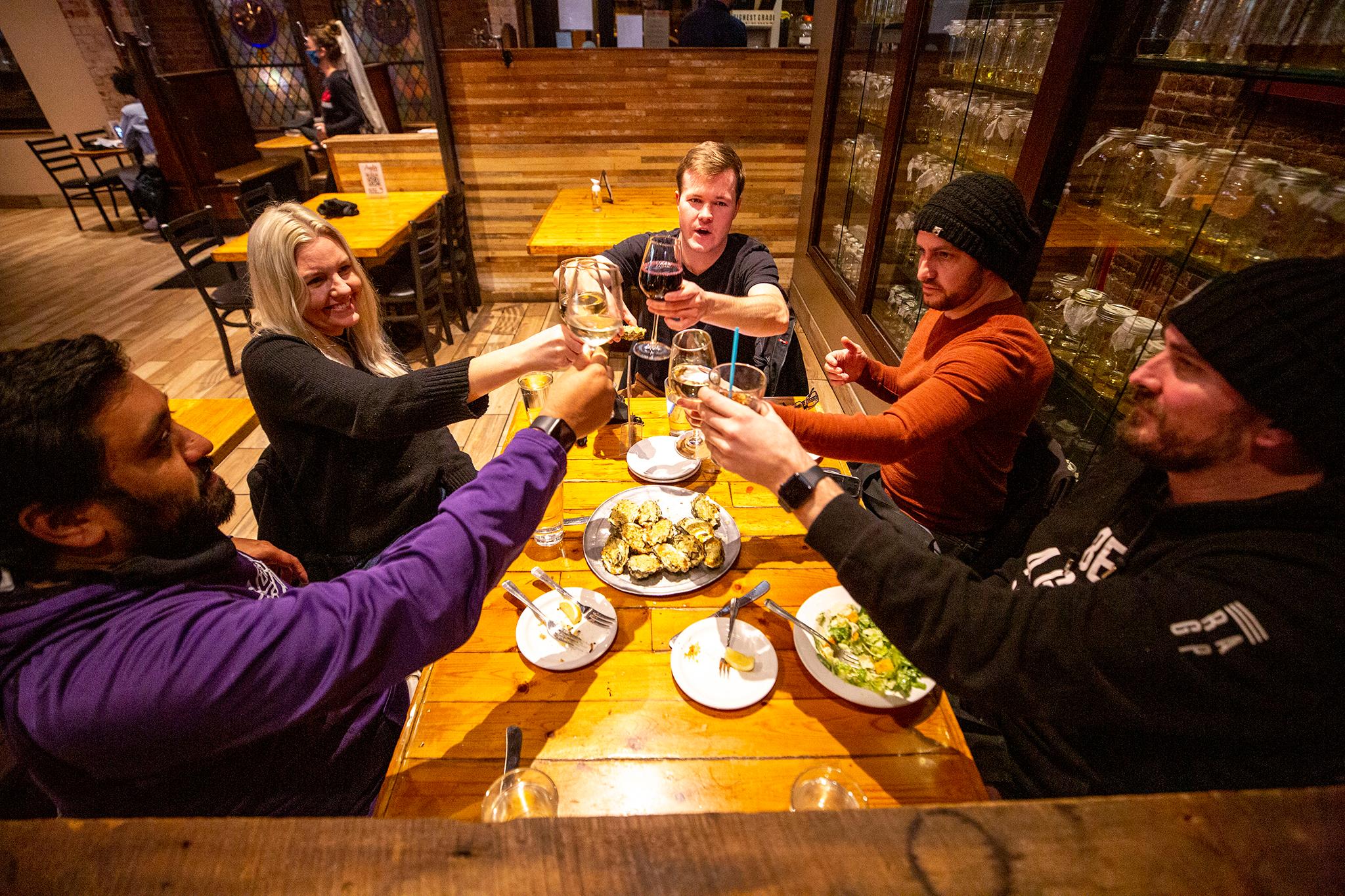
In the space of a few weeks starting around Halloween, the number of COVID-19 patients in Dr. Sandeep Vijan’s Pueblo hospital grew from 10 to almost 140.
“We were at that point all hands on deck for COVID care,” said Vijan, chief medical officer at Parkview Medical Center. Staff were pushed to the limit as they shut down all non-emergency surgeries and triaged resources. At one point they were so full they had to transfer COVID patients to other hospitals. The county brought a freezer truck to the coroner’s office to handle the bodies.
“The pace of the ill, that’s what really surprised everybody,” Vijan said. “That was the darkest hour.”
That experience makes Vijan uniquely positioned to know how quickly changes in public policy can combine with the actions of the public to alter the course of the pandemic.
Today, he is watching what might result from the decision by Gov. Jared Polis to roll back COVID-19 restrictions across the state with a mixture of understanding and concern.
“I'm sympathetic to all angles of this crisis,” Vijan said, including its impact on businesses, the economy, patients and hospitals like his. “This is a multi-faceted problem. We as Coloradans have managed it as best we can.”
When balancing public health and economics becomes a gamble
Polis, who did not consult with local public health officials before announcing on social media his decision to move counties from “red” restrictions to “orange” — primarily allowing a return to limited indoor dining — is among a large group of the nation’s governors trying to balance the economy and public health.
Polis insisted again Friday that he always comes down on the side of health, but other factors are important too.
“We as a state have always sought to balance the impact of the coronavirus on people and on families,” Polis said.
The governor added there’s the “dramatic impact” when people are hospitalized.
There’s an economic impact for people who can’t make rent, have lost hours or jobs, he said. There’s a social and psychological impact for those in a senior living center to not have poker or movie night, or if it’s hard for people to attend church.
“Economics is public health,” he said. “Red is a very restrictive category.”
Others see strong public health measures as paving the way for better economic and social conditions.
“This will get me in trouble probably,” said Dr. Mark Johnson, Jefferson County’s Interim Public Health Director and Medical Director. “But my sense is that the governor listens to his business colleagues and business interests more than he does to his public health interests.”
A little more than a week in, through Thursday’s COVID-19 data, the result of Polis’s gamble remains uncertain. The percentage of tests that come back positive in the state has grown steadily since Dec. 26, and while the number of people hospitalized dropped and then has flattened, it is hard for experts to imagine that continuing if the number of infections keeps growing.
Instead of a flattening the curve, riding a rollercoaster of infections
Things can deteriorate quickly, said Dr. John Swartzberg, a clinical professor emeritus and expert in infectious diseases at the UC Berkeley School of Public Health.
He said he was “just in awe” Colorado avoided a post-Thanksgiving surge, but “this would be, in my opinion, a terrible time to open things up further when you have no idea what the consequences of Christmas and New Year's are going to be to Coloradans in January.”
California has a similar dial system to Colorado’s. When it loosened restrictions last summer, only to see the state get swamped by new infections.
“You can’t change from one color to another too quickly,” Swartzberg said. “And if you do you’re going to get in trouble again. And that’s what happened in California.”
Shifting between preserving jobs and protecting public health has all but guaranteed that curves tracking the number of infections in states and the nation look like the humps in a roller coaster.
“Bringing down infections is the best way to get a community back to normal,” said Robert Hecht, president of Pharos Global Health Advisors and a professor of clinical epidemiology from the Yale School of Public Health.
He lives in Massachusetts, a state that was able to bring high levels of transmission down last spring, but has seen cases and hospitalizations rise again in recent months. Hecht co-wrote an op-ed in the Boston Globe last month urging residents of the risks as reopening continued there.
“Indoor activities should be kept to the shortest time possible,” he and a colleague wrote.
“We’re really at a crossroads. The next few months will be critical,” Hecht said in an interview, both of Colorado and the nation. “Why take that risk (to ease restrictions) right now?” he asked.
“I really wonder about a state like Colorado moving the goalposts.”
On Friday, Polis said he remained confident that the state’s hospitals are able to handle any increase in cases. He attributed the growth in the percentage of positive cases to a reduced number of people seeking tests over the holidays.
In the week of Dec. 26, when the positivity increase began, just 150,000 tests were conducted in the state, down from more than 250,000 the week before.
The governor said the time was right to move to a less restrictive posture, “as soon as the hospital capacity showed sufficient room.”
He said hospitalizations had dropped from over 1,600 around the end of November to just under 900 hospitalizations in January. That, he said, means, “we can have a little bit more of a sustainable way of living in Colorado from a social, emotional and economic perspective while monitoring the health data in real time every day.”
Dining at restaurants and other indoor activities are inherently risky
But while Polis is placing a lot of faith in both the efficacy and supply of vaccines, his decision to allow indoor restaurant dining in the face of research on how easily the virus is spread in that circumstance, even limited to 25 percent of capacity or 50 people, strikes experts as risky.
“It does seem to me to be a bold step,” said Dr. S. Patrick Kachur, a public health physician, with Columbia University’s Mailman School of Public Health.
He said New York City has faced similar tensions about reopening some businesses, including restaurants, after the virus was brought under control following a brutal peak last spring.
But Kachur says the confined spaces, artificial ventilation, loud talking, inability of people to wear masks while eating makes indoor dining “a very risky situation and I do think we have to be cautious about decisions that affect indoor dining.”
The team that models Colorado’s coronavirus forecasts was not consulted before the governor eased the rules.
“We were not involved in that policy decision, no,” said Dr. Jonathan Samet, dean of the Colorado School of Public Health.
But he said these calls are inherently difficult.
“I think the question of when to begin to lighten up policy measures that improve transmission control is a really tough challenge,” Samet said. “And so I understand the state and the governor in particular walk a fine line between protecting public health and assuring the state's economic health.”
The governor’s move promised to have implications most immediately for businesses now able to open at higher capacity and schools looking to reopen to in-person learning, after months of going remote.
“This is something we’ve been pushing for,” said Sonia Riggs, president and CEO of the Colorado Restaurant Association. “Every week counts to this struggling industry.” She described surveys of its 3500 plus members that found nearly all lost revenue in 2020, with an average loss of 40 percent. That’s a devastating figure in an industry where profit margins can be five percent or less. She said the pandemic has cost 64,000 Colorado restaurant workers their jobs.
“I would say nearly all restaurants are in dire financial straits,” Riggs said. “Twenty-five percent capacity, while we are certainly grateful to have it, really isn’t going to help folks stay open much longer.” She said increased capacity coupled with federal funding to help restaurants survive is critical.
“It’s a great decision...this completely came as a surprise,” said Beth Gruitch, owner of Rioja and three other Denver restaurants. Her eateries rely on in-person dining, rather than take out, and the pandemic’s economic punch had cut her staff of 200 down to 60. “It’s really difficult” to stay afloat now she said, adding that her restaurants invested $10,000 to make outdoor dining viable.
She fumed that the community’s restaurants have struggled to stay open as people have been allowed to do something she sees as much more dangerous: traveling by air and eating at airports. Denver International Airport has “been open at full capacity. They haven’t had any restrictions at the restaurants,” she said.
The airport has insisted it’s implemented numerous public health measures. But Gruitch thinks the airport has been a bigger culprit than restaurants.
“That's really disappointing,” she said. “It was all the people that are, I'm sorry, irresponsibly traveling, and all the restaurants (at DIA) are open and you can go there and have full dinners and there's not even six foot distancing.”
Meanwhile, the governor’s move to ease virus restrictions comes as schools around the state are hoping to welcome students back to school in person.
“We do worry and wonder about the timing of this decision,” said Amie Baca-Oehlert, president of the Colorado Education Association, who said it caught the teacher’s union off guard. She worried COVID-19 cases could climb too sharply wiping out extensive new plans.
“We are certainly worried about what it could mean for our ability to implement those plans for return to in-person learning,” she said.
Patrick Mueller, a Lakewood parent, is watching closely to see how the situation will unfold for his first grader. He described his son as an extrovert, who hasn’t had a playdate in seven weeks “with somebody younger than me” and has been looking forward to getting back to school.
Mueller said he was hoping it would be possible, but, “we don’t want it to happen if it’s not safe.”
Local public health leaders in Colorado stressed cooperation was critical, while suggesting sudden changes in rules make it harder to communicate the changes with nuance.
“We all need to be paddling together and working in the same direction,” said Liane Jollon, executive director of San Juan Public Health in Durango. “Working together on a global pandemic takes such an enormous whole of government and whole of community response.”
The region in southwest Colorado covered by her department saw a decline in cases in December and was on the path to drop below 350 cases per 100,000 people, the threshold to move down from red to range on the dial, in the coming weeks.
The challenges in communicating with the public are intense, she said, with so many factors, like infection spread, economic impact, a return to school to consider.
“I think it’s a key moment and it’s a confusing moment,” Jollon said.
Tom Gonzalez, the public health director in Larimer County, agreed.
“I do believe the next two weeks are going to be critical,” Gonzalez said. "If we let our guard down, if we throw caution to the wind, if we're not wearing our mask, if we start mixing households, then that trajectory could go the wrong way. Up.”









